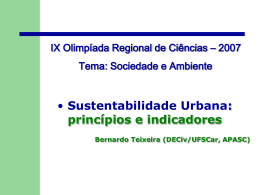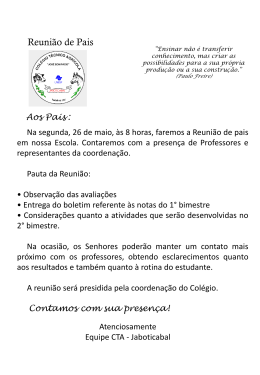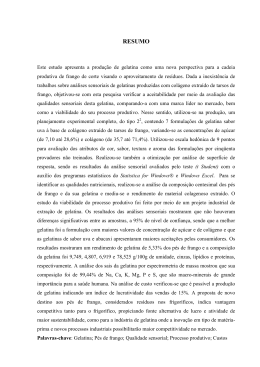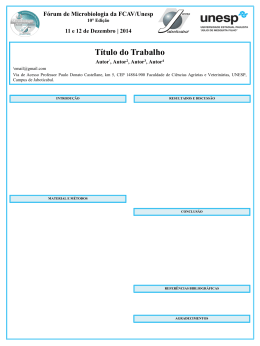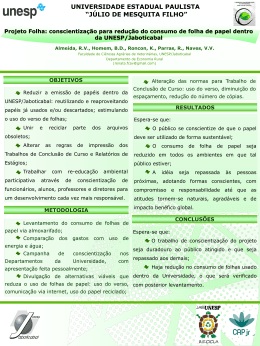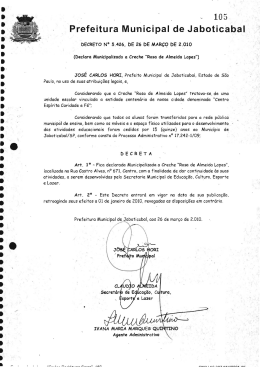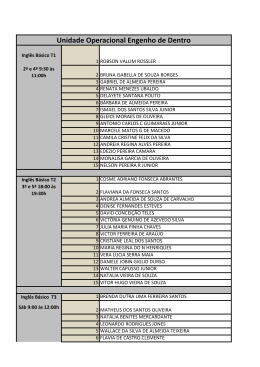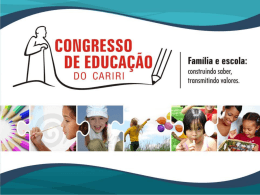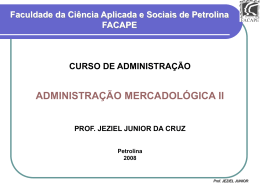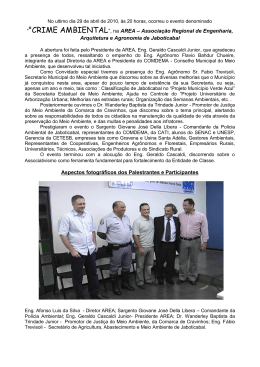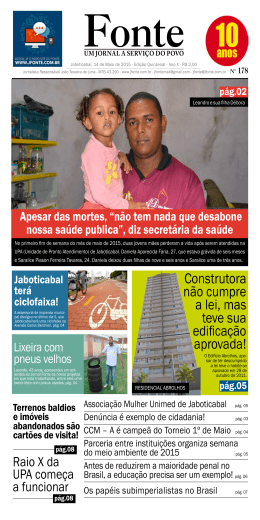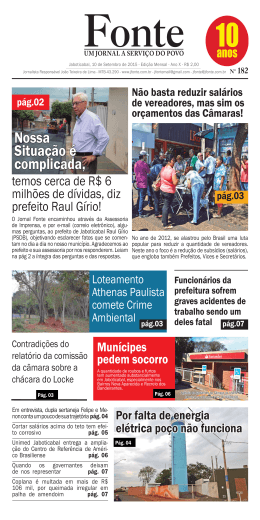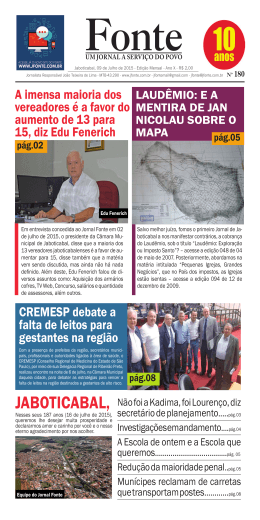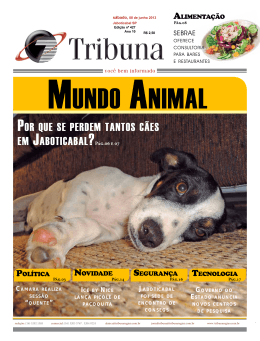PRODUCTION OF A PRODUCT SIMILAR TO GELATIN FROM CHICKEN FEET COLLAGEN POLIANA F. DE ALMEIDA1, FELIPE A. CALARGE2, JOSÉ CARLOS C. SANTANA3 ABSTRACT: Chicken feet can be used as an alternative source of collagen for the development of new products. In this sense, the aim of this study was the production of a product similar to gelatin from collagen extracted from chicken feet and the evaluation of sensory quality. The products were produced in two distinct flavors, with grape flavor called GU and pineapple flavor called GA. Subsequently, we compared these formulations with gelatin of a trademark established in the market. We used in the verification of sensory acceptability of products a hedonic scale of 9 points and the availability of consuming the product by 30 untrained tasters. According to the results, all formulations showed good levels of acceptability, indicating the collagen from chicken feet as an alternative source of high quality in the production of gelatin. KEYWORDS: chicken feet; quality; sensory analysis, utilization of byproduct; new product development. PRODUÇÃO DE UM PRODUTO SIMILAR A GELATINA A PARTIR DE COLÁGENO DE FRANGO RESUMO: Os pés de frango podem ser aproveitados como fonte alternativa de colágeno no desenvolvimento de novos produtos. Neste sentido, objetivou-se com o presente estudo a produção de um produto similar a gelatina a partir de colágeno extraído de pés de frango e a avaliação da qualidade sensorial. Os produtos foram elaborados com dois sabores distintos, sendo uva denominada GU e sabor abacaxi denominada GA. Posteriormente, compararam-se as formulações com uma gelatina de marca comercial consolidada no mercado. Utilizou-se, na verificação da aceitação sensorial, dos produtos escala hedônica de 9 pontos e a disponibilidade em se consumir o produto mediante 30 provadores não treinados. De acordo com os resultados, todas as formulações obtiveram bons níveis de aceitabilidade, indicando o colágeno dos pés de frango como fonte alternativa de elevada qualidade na produção de gelatinas. PALAVRAS-CHAVE: pés de frango; qualidade; análises sensoriais; aproveitamento de subproduto; desenvolvimento de novo produto. INTRODUCTION According to FIORELLI et al. (2010) the broiler industry in Brazil has shown strong growth regarding to productive and commercial factors, standing out in the international market since 1995 with higher rates of growth in production and worldwide export. This led Brazil in 2004to hold the position of world's largest exporter in that year. This position is maintained until the present time, with an annual production of 3.8 million tons in 2010, and the forecast for 2011 is to surpass 4 million tons (AVISITE, 2011; NASCIMENTO et al., 2011; SALGADO & NAAS, 2010). The southeast region of Brazil is the second major producer region in the country, with 28% of housed birds, especially in the state of São Paulo, with 18% (NASCIMENTO et al., 2011; ____________________________________ 1 Bel Tecnologia de Alimentos, Mestre em Engenharia de Produção pela UNINOVE, Profa. Titular do Instituto Federal de Educação, Ciência e Tecnologia de Mato Grosso - Campus São Vicente-MT, Fone: (65) 33412106, e-mail: [email protected], Bolsista PROSUP/CAPES. 2 Engenheiro Mecânico, Doutor em Engenharia Mecânica e em Economia pela UNICAMP, Prof. Titular do Programa de PósGraduação em Engenharia de Produção, UNINOVE, [email protected]. 3 el B Química Industrial, Doutor em Engenharia Química pela UNICAMP, Bolsista do CNPq em Produtividade em Pesquisa, Prof. Titular do Programa de Pós-Graduação em Engenharia de Produção, UNINOVE, [email protected]. Recebido pelo Conselho Editorial em: 2-6-2011 Aprovado pelo Conselho Editorial em: 28-5-2013 Eng. Agríc., Jaboticabal, v.33, n.6, p.1289-1300, nov./dez. 2013 Poliana F. de Almeida, Felipe A. Calarge, José Carlos C. Santana 1290 SALGADO & NAAS, 2010). Great part of the destination of export of chicken meat is countries with specific requirements of housing, related to the welfare of the birds (FURTADO et al., 2010; OWADA et al., 2007). The per capita consumption of chicken meat has increased significantly in recent years, from 29.9 kg in 2000 to 38.1 kg in 2009. This increase in consumption due to lower product price and technological gains (UBA, 2009), generates a large amount of underutilized housing components. The waste and effluents from the production chain of meat and products of poultry, cattle and swine production have high polluting power and if arranged in inadequate methods, generate serious environmental problems that lead to degradation of soil, surface and ground water environments, and health problems and death of living beings, by the presence of pathogenic microorganisms and animals and poisonous insects (ABREU NETO & OLIVEIRA, 2009; SILVA & ROSTON, 2010; DUDA & OLIVEIRA 2009a and 2009b; MATOS et al., 2010; ORRICO JUNIOR et al., 2010a). An alternative to reduce the environmental impacts caused by incorrect disposal is the treatment and/or reuse of these wastes (PADILHA et al., 2006). Recent researches mention the reuse of poultry litter and carcass composting for obtaining humus (ORRICO JUNIOR et al., 2010b). In general, biodigesters are used to degrade wastewater from swine (ORRICO JUNIOR et al., 2010a) or cattle raising (XAVIER &LUCAS JUNIOR, 2010), which can be used to generate methane gas to be used as fuel and mud that can be used as organic fertilizer (humus). Similar to other agricultural activities, the poultry production generates a large amount of waste that, if well managed, could become not only an important source of income and add value to the activity, but also a sustainable production model that is increasingly becoming a requirement of the market. Therefore, the adoption of a system of waste treatment is necessary in order to avoid possible contamination of the environment (ORRICO JUNIOR et al., 2010a and 2010c). The waste may contain many substances of high value. If appropriate technology is employed, this material can be converted into commercial products or raw materials for secondary processes (GIRAÇOL et al., 2011). In this sense, many food residue before disposed of as useless substances currently are transformed into products of wide commercial acceptance. According to ROQUE & SELL (2009) an alternative to reuse waste is to develop new products that use or give them a nobler destiny, with more commercial value. Alternative ways of recycling or reuse of solid waste should be searched. For this purpose, new technologies are been developed, such as the use of different materials to cover the installations (FIORELLI et al., 2010), improvement of animal’s food quality (EYNG et al., 2011; MINAFRA et al., 2010; NASCIMENTO et al., 2009) and the use of biogas for heating of poultry houses (SANTOS et al., 2007). ORRICO JUNIOR et al. (2010c) investigated the technical feasibility of using anaerobic digestion to treat waste from poultry litter and carcasses of pre-composted poultry. Thus, the raw material that is considered a waste in some areas, in other areas is the base of traditional byproducts with added value potential. We mention some Asian countries, where chicken feet are considered a delicacy, but in Brazil, it is one of the poultry cuts that consumers are less interested (PADILHA et al., 2006). Thus, the selling of a ton of chicken feet is below 1.00 R$/t. These characteristics of the domestic market are crucial to set your low sale value (MFRURAL, 2010). With the increasing world population, it is necessary to search for alternative food as a way to meet the demand. However, to achieve their goals, these alternative sources should not only contain nutritious food produced in large scale and low cost but also provide good sensory characteristics (COSTA et al., 2008). The development of new food products is been investigated through the discovery of new food sources or reuse of byproducts or waste. To this end, in addition to the sensory aspects, nutritional aspects should be taken into account, so that they can meet any vitamin or minerals need without a rejection of the product by the consumer. In this context there are the so-called functional foods (BARIMALAA & OKOROJI, 2009; LENTZ, 2008). Eng. Agríc., Jaboticabal, v.33, n.6, p.1289-1300, nov./dez. 2013 Production of a product similar to gelatin from chicken feet collagen 1299 IRWANDI, J.; FARIDAYANTI, S.; MOHAMED, E. S. M.; HAMZAH, M. S.; TORLA, H. H.; CHE MAN, Y. B. Extraction and characterization of gelatin from different marine fish species in Malaysia. International Food Research Journal, v. 16, p. 381 – 389, 2009. KASANKALA, L. M., XUE, Y., WEILONG, Y., HONG, S. D.; HE, Q. Optimization of gelatin extraction from grass carp (Catenopharyngodon idella) fish skin by response surface methodology, Bioresource Technology, Essex, v. 98, n. 17, 2007. LENTZ, K. A. Current methods for predicting human food effect - Mini-Review. The AAPS Journal, v. 10, n. 2, p. 282–288, 2008. LIMA, E. R.; OLIVEIRA, R. A.; AMBROSIO-UGRI, M. C. B.; BARROS, S. T. D.; JÚNIOR, C. B. Recuperação da solução de soda cáustica usada no tratamento do couro bovino na produção de gelatina. Ciência e Tecnologia de Alimentos, Campinas, v. 28, n. 1, p. 98-106, 2008. MADRONA, G. S.; ZOTARELLI, M. F.; BERGAMASCO, R.; BRANCO, I. G. Estudo do efeito da adição de soro de queijo na qualidade sensorial do doce de leite pastoso. Ciência e Tecnologia de Alimentos, Campina Grande, v. 29, n. 4, p. 862-833, 2009. MATOS, A. T.; MAGALHAES, M. A.; SARMENTO, A. P. Perda de carga em filtros orgânicos utilizados no tratamento de água residuária de suinoculturas. Engenharia Agrícola, Jaboticabal, v. 30, n. 3, p. 527-537, 2010. MINAFRA; C. S.; MARQUES; S. F. F.; STRINGHINI, J. H.; ULHOA, C, J.; REZENDE, C. S. M.; SANTOS, J. S.; MORAES, G. H. K. Perfil bioquímico do soro de frangos de corte alimentados com dieta suplementada com alfa-amilase de Cryptococcus flavus e Aspergillus niger HM2003. Revista Brasileira de Zootecnia, Viçosa-MG, v. 39, n. 12, p. 2991-2996, 2010. MFRURAL. Classificados: Produtos rurais: preço dos pés de frango. Atualizado em 28/01/2010. Disponível em: <http://comprarvender.mfrural.com.br/ detalhe.aspxcdp=44686&nmoca=procurocompro-compro-pes-de-frango> Acesso em: 22 fev. 2010. NASCIMENTO, G. A. J.; RODRIGUES, P. B.; FREITAS, R. T. F.; BERTECHINI, A. G.; LIMA, R. R.; PUCCI, L. E. A. Equações de predição para estimar os valores energéticos de alimentos concentrados de origem vegetal para aves utilizando a metanálise. Revista Brasileira de Zootecnia, Viçosa-MG, v. 38, n. 7, p. 1265-1271, 2009. NASCIMENTO, G. R. do; PEREIRA, D. F.; NÄÄS, I. A.; RODRIGUES, L. H. A. Índice fuzzy de conforto térmico para frangos de corte. Engenharia Agrícola, Jaboticabal, v. 31, n. 2, p. 219-229, 2011. ORRICO JUNIOR, M. A. P.; ORRICO, A. C. A.; LUCAS JUNIOR, J. Avaliação de parâmetros da biodigestão anaeróbia de dejetos de suínos alimentados com dietas à base de milho e sorgo. Engenharia Agrícola, Jaboticabal, v. 30, n. 4, p. 600-607, 2010a. ORRICO JUNIOR, M. A. P.; ORRICO, A. C. A.; LUCAS JUNIOR, J. Compostagem dos resíduos da produção avícola: cama de frangos e carcaças de aves. Engenharia Agrícola, Jaboticabal, v. 30, n. 3, p. 538-545, 2010b. ORRICO JUNIOR, M. A. P.; ORRICO, A. C. A. e LUCAS JUNIOR, J. Biodigestão anaeróbia dos resíduos da produção avícola: cama de frangos e carcaças. Engenharia Agrícola, Jaboticabal, v. 30, n. 3, p. 546-554, 2010c. OSAWA, C. C.; FONTES, L. C. B.; MIRANDA, E. H. W.; CHANG, Y. K.; STEEL, C. J. Avaliação físico-química de bolo de chocolate com coberturas comestíveis à base de gelatina, ácido esteárico, amido modificado ou cera de carnaúba. Ciência e Tecnologia de Alimentos, Campinas, v. 29, n. 1, p. 92-99, 2009. Eng. Agríc., Jaboticabal, v.33, n.6, p.1289-1300, nov./dez. 2013 Poliana F. de Almeida, Felipe A. Calarge, José Carlos C. Santana 1300 OWADA, A. N.; NAAS, I. A.; MOURA, D. J.; BARACHO, M. S. Estimativa de bem-estar de frango de corte em função da concentração de amônia e grau de luminosidade no galpão de produção. Engenharia Agrícola, Jaboticabal, v. 27, n. 3, p. 611 – 618, 2007. PADILHA, A. C. M; SILVA, T. N. da; SAMPAIO, A. Desafios de adequação à questão ambiental no abate de frangos: o caso da Perdigão Agroindustrial – Unidade Industrial de Serafina Corrêa – RS. Teoria e Evidência Econômica, v. 14, p. 109- 125, 2006. Número especial. ROQUE, V. F.; SELL, I. Alternativas de utilização de resíduos gerados em frigoríficos de aves. 2004. Disponível em: <http://pessoal.utfpr.edu.br/marlenesoares/arquivos /Artigo73.pdf> Acesso em: 27 set. 2009. ROMAN, J. A.; MENDONÇA, S. N. T. G. de.; SGARBIERI, V. C. Avaliação físico-química, microbiológica, sensorial e atitude do consumidor de gelatina de elevado valor nutricional. Alimentos e Nutrição, Marília, v. 20, n. 1, p. 41-51, 2009. SALGADO, D. D.; NAAS, I. A. Avaliação de risco à produção de frango de corte do Estado de São Paulo em função da temperatura ambiente. Engenharia Agrícola, Jaboticabal, v. 30, n. 3, p. 367376, 2010. SANTANA, J. C. C.; DIAS, C. G.; SOUZA, R. R.; TAMBOURGI, E. B. Applying of neural network on the wine sensorial analysis from barbados cherry. Journal of Food Process Engineering, Westport, v. 33, p. 365 – 378, 2010. SANTOS, T. M. B.; LUCAS JÚNIOR, J.; SILVA, F. M. Avaliação do desempenho de um aquecedor para aves adaptado para utilizar biogás como combustível. Engenharia Agrícola, Jaboticabal, v. 27, n. 3, p. 658-664, 2007. SCHUMANN, S. P. A.; POLÔNIO, M. L. T.; GONÇALVES, E. C. B. de A. Avaliação do consumo de corantes artificiais por lactantes, pré-escolares e escolares. Ciência e Tecnologia de Alimentos, Campinas, v. 28, n. 3, p. 534-539, 2008. SEGTNAN, V. H.; ISAKSSON, T. Temperature, sample and time dependent structural characteristics of gelatin gels studied by near infrared spectroscopy. Food Hydrocolloids, Oxford, v. 18, n. 1, p. 1-11, 2004. SEVERO JUNIOR, J. B.; ALMEIDA, S. S.; NARAIM, N.; SOUZA, R. R.; SANTANA, J. C. C.; TAMBOURGI, E. B. Wine Clarification from Spondias lutea L. Pulp by Hollow Fiber Membrane System, Process Biochemistry, London, v. 42, n. 11, p. 1516-1520, 2007. SILVA; E. M. da; ROSTON; D. M. Tratamento de efluentes de sala de ordenha de bovinocultura: lagoas de estabilização seguidas de leito cultivado. Engenharia Agrícola, Jaboticabal, v. 30, n. 1, p. 67-73, 2010 SILVA, E.; YANAGI JÚNIOR, T.; BRAGA JÚNIOR, R. A.; LOPES, M. A.; DAMASCENO, F. A.; SILVA, G. C. A. Desenvolvimento e validação de um modelo matemático para o cálculo da área superficial de frangos de corte. Engenharia Agrícola, Jaboticabal, v. 29, n. 1, p. 1-7, 2009. SILVA, F. A. S.; DUARTE, M. E. M.; CAVALCANTI-MATA, M. E. R. M. Nova metodologia para interpretação de dados de análise sensorial de alimentos. Engenharia Agrícola, Jaboticabal, v. 30, n. 5, p. 967-973, 2010. UBA. União Brasileira de Avicultura. Relatório anual 2009. Brasília 2009. Disponível em: <http://www.uba.org.br> acesso em: 12 jul. 2010. XAVIER, C. A. N.; LUCAS JUNIOR, J. Parâmetros de dimensionamento para biodigestores batelada operados com dejetos de vacas leiteiras com e sem uso de inóculo. Engenharia Agrícola, Jaboticabal, v. 30, n. 2, p. 212-223, 2010. Eng. Agríc., Jaboticabal, v.33, n.6, p.1289-1300, nov./dez. 2013
Download
